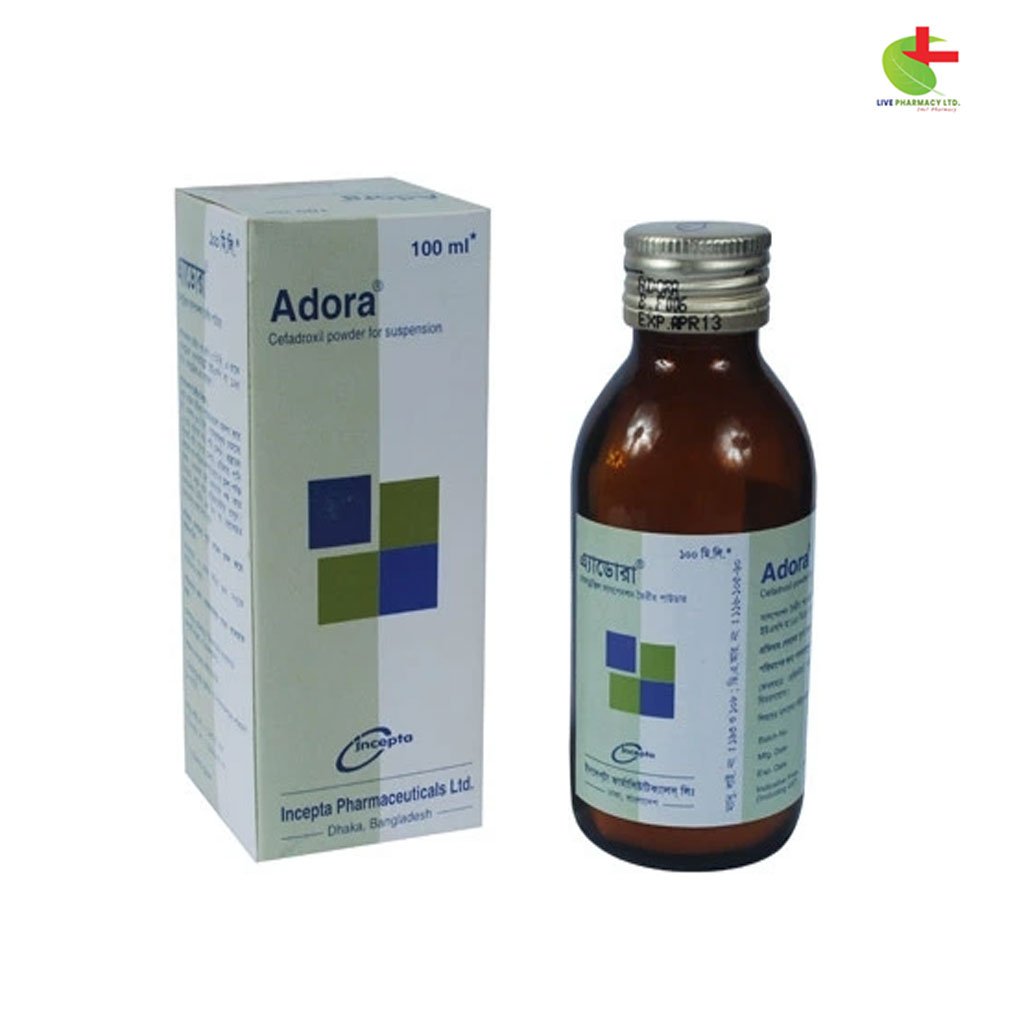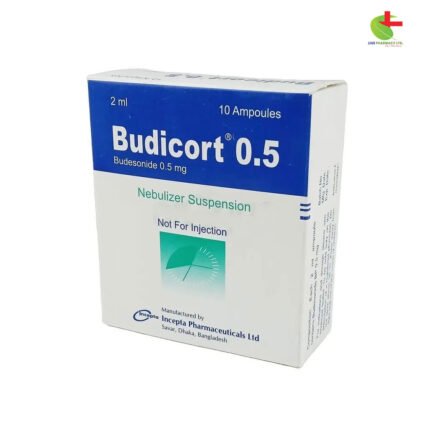Adora Suspension
90.00৳ Bottle (100ml)
- Adora is indicated for treating infections such as streptococcal pharyngitis, bronchopneumonia, urinary tract infections, and skin infections.
- It works by inhibiting bacterial cell wall synthesis, leading to cell death.
- Dosage varies based on the patient’s age, weight, and renal function, with a maximum of 4 g per day.
- Common side effects include nausea, diarrhea, and skin rashes, while severe allergic reactions are rare.
- Caution is advised for patients with a history of allergies or renal impairment.
 Brand
Brand
|
Incepta Pharmaceuticals Ltd |
|---|---|
 Generics
Generics
|
Cefadroxil Monohydrate |
 Type
Type
|
Powder for Suspension |
Indications
Adora is prescribed for the management of the following infections:
- Streptococcal Pharyngitis and Tonsillitis
- Bronchopneumonia and Bacterial Pneumonia
- Uncomplicated Urinary Tract Infections: including pyelonephritis and cystitis
- Skin and Soft Tissue Infections: such as abscesses, furunculosis, impetigo, erysipelas, pyoderma, and lymphadenitis.
Always consult a registered healthcare professional before taking this medication.
Pharmacology
Cefadroxil functions by inhibiting the synthesis of the bacterial cell wall. It binds to one or more penicillin-binding proteins (PBPs), obstructing the final transpeptidation step in peptidoglycan synthesis. This action prevents cell wall biosynthesis, leading to cell death in bacteria.
Dosage & Administration
The appropriate dosage of Cefadroxil varies based on pathogen susceptibility, disease severity, and the patient’s clinical status (renal and hepatic function).
For Streptococcal Pharyngitis and Tonsillitis:
- Adults and Adolescents (>40 kg) with Normal Renal Function: 1000 mg once daily for a minimum of 10 days. The dosage may be adjusted as necessary.
- Children (<40 kg) with Normal Renal Function: 30 mg/kg/day once daily for at least 10 days.
For Bronchopneumonia, Bacterial Pneumonia, Urinary Tract Infections, and Skin & Soft Tissue Infections:
- Adults and Adolescents (>40 kg) with Normal Renal Function: 1000 mg twice daily.
- Children (<40 kg) with Normal Renal Function: 30-35 mg/kg/day divided into two doses.
Children may benefit from an increased dosage of up to 100 mg/kg/day. Adults may require higher dosages depending on the infection’s severity, with a maximum limit of 4 g per day. Chronic urinary tract infections may necessitate extended treatment, along with ongoing susceptibility testing and clinical monitoring. Cefadroxil 500 mg is not advised for infants and children under 6 years. Liquid formulations are recommended for younger children and those weighing less than 40 kg.
Renal Impairment:
In patients with renal impairment, dosages should be adjusted based on creatinine clearance to prevent cefadroxil accumulation. A guideline for reduced dosing is as follows:
- Creatinine Clearance 50-25 ml/min/1.73 m²: 500 mg-1000 mg every 12 hours
- Creatinine Clearance 25-10 ml/min/1.73 m²: 500 mg-1000 mg every 24 hours
- Creatinine Clearance 10-0 ml/min/1.73 m²: 500 mg-1000 mg every 36 hours
- Children (<40 kg) with Renal Impairment: Cefadroxil is contraindicated in cases of renal insufficiency or those requiring haemodialysis.
- Dosage for Haemodialysis Patients: 63% of a 1000 mg dose is eliminated during 6 to 8 hours of haemodialysis. An additional dose of 500 mg-1000 mg of cefadroxil should be administered at the end of the dialysis session.
Hepatic Impairment:
No dosage adjustments are necessary for patients with hepatic impairment.
Elderly:
As cefadroxil is primarily excreted via the kidneys, dosage may need to be adjusted based on renal function.
Administration:
Cefadroxil can be taken with or without food, as its bioavailability is unaffected. In cases of gastrointestinal upset, it may be taken with meals.
Duration of Therapy:
Treatment should continue for 2 to 3 days beyond the resolution of acute symptoms or evidence of bacterial eradication. For infections caused by Streptococcus pyogenes, a treatment duration of up to 10 days may be warranted.
Always consult a registered healthcare professional before taking this medication.
Interactions
Co-administration with anticoagulants may prolong prothrombin time and increase bleeding risk. The use of probenecid may reduce cefadroxil elimination.
Contraindications
Cefadroxil is contraindicated in patients with a known hypersensitivity to any cephalosporins or a history of severe allergic reactions to penicillins or other beta-lactam antibiotics. It should not be combined with bacteriostatic antibiotics (e.g., tetracyclines, erythromycin) due to potential antagonistic effects. Use with aminoglycosides, polymyxin B, colistin, or high-dose loop diuretics should be avoided to prevent nephrotoxic effects.
Cefadroxil does not penetrate the central nervous system (CNS) and is not recommended for meningitis treatment. Penicillin remains the first choice for treating Streptococcus pyogenes infections and preventing rheumatic fever. Caution is advised for patients with a history of severe allergies or asthma, as well as those with non-severe penicillin hypersensitivity. Adjustments may be required for patients with renal impairment, and caution is necessary for those with gastrointestinal issues, especially colitis. If allergic reactions occur (e.g., hives, rash, itching, decreased blood pressure, increased heart rate, respiratory issues, collapse), treatment should be halted immediately, and appropriate interventions initiated.
Routine monitoring of blood counts and regular assessment of hepatic and renal function are recommended during prolonged therapy. Superinfections with fungi (e.g., Candida) may occur with extended use. Severe and persistent diarrhea may indicate antibiotic-associated pseudomembranous colitis, requiring immediate cessation of cefadroxil and appropriate treatment. The Coombs’ test may yield transiently positive results during or after cefadroxil therapy, applicable to newborns whose mothers received cephalosporins prior to delivery. It is important to measure urinary sugar enzymatically during treatment, as reduction tests may produce falsely elevated values.
Side Effects
Infections and Infestations: Rare occurrences include vaginal yeast infections and thrush.
Blood and Lymphatic System Disorders: Rare side effects include eosinophilia, thrombocytopenia, leukopenia, neutropenia, agranulocytosis, and very rarely, hemolytic anemia.
Immune System Disorders: Rarely, serum sickness-like reactions may occur, with very rare instances of immediate allergic reactions (anaphylactic shock).
Nervous System Disorders: Very rare side effects include headache, insomnia, dizziness, and nervousness.
Gastrointestinal Disorders: Common side effects encompass nausea, vomiting, diarrhea, dyspepsia, abdominal pain, and glossitis; very rarely, pseudomembranous colitis may occur.
Hepatobiliary Disorders: Rare cases of cholestasis and idiosyncratic hepatic failure have been reported.
Skin and Subcutaneous Tissue Disorders: Common side effects include itching, rash, allergic reactions, and urticaria; very rare occurrences of Stevens-Johnson syndrome and erythema multiforme have been noted.
Musculoskeletal and Connective Tissue Disorders: Rare instances of arthralgia.
Renal and Urinary Disorders: Rarely reported interstitial nephritis.
General Disorders: Fever is uncommon, while fatigue is very rare.
Pregnancy & Lactation
While animal studies and clinical experience show no evidence of teratogenicity, the safety of cefadroxil during pregnancy has not been fully established. Low concentrations of cefadroxil are found in breast milk; potential effects on infants include sensitization, diarrhea, or fungal colonization. Thus, the use of cefadroxil during pregnancy and lactation should be approached with caution.
Precautions & Warnings
Cefadroxil may bind to cholestyramine, potentially reducing its bioavailability. The concurrent use of probenecid may lead to increased plasma concentrations due to decreased renal elimination.
Overdose Effects
While no clinical reports on cefadroxil overdose are available, symptoms may include nausea, hallucinations, hyperreflexia, extrapyramidal symptoms, altered consciousness, or renal impairment based on experience with other cephalosporins.
Therapeutic Class
First Generation Cephalosporins
Storage Conditions
Store in a dry place away from light and heat. Keep out of reach of children.













Reviews
There are no reviews yet.